How to declutter your home storage with ease?
Home storage areas in Miami tend to fill up fast. Closets, pantries, and basements become holding spaces for things you no longer use. Over time, these spaces stop serving a purpose and start creating stress. Decluttering helps you take back control. You make space, improve daily routines, and remove what no longer belongs. The process doesn’t need to be complicated. A few simple habits and consistent choices can lead to lasting results. This guide by our movers and packers in Miami shares clear, practical ways to declutter your home storage with ease so that every part of your space works better for your life.
Understanding the importance of decluttering
Clutter builds slowly. A few extra items in a closet or an unchecked pile in the basement might not seem like much. But over time, disorganized storage starts to affect how your home functions. You spend more time looking for things and less time using what you already have.
Decluttering solves these small but persistent problems. The benefits are noticeable right away as you:
- Find what you need faster
- Create more usable space
- Reduce frustration in daily routines
Even with good intentions, many avoid decluttering because they feel overwhelmed or emotionally attached to items. Some people also believe they must set aside a full weekend just to get started.
Instead of aiming for a complete reset, start small and stay focused. You don’t need perfection. You need progress. Clear goals and a simple system make it easier to move forward, without stalling or second-guessing every item.
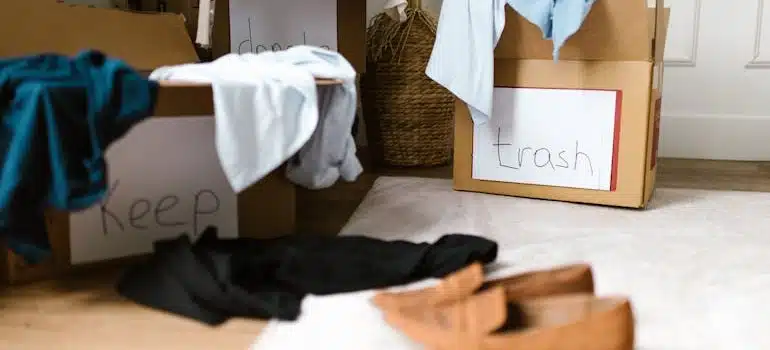
Preparing to declutter
Before you sort a single item, take time to prepare. In general, people start decluttering without a clear plan. That often leads to frustration or unfinished tasks. A few small steps in advance will help you stay focused and complete each space with less stress.
If you live in South Florida and want to simplify the setup, many local companies offer help. Professional packing services in Miami can provide packing materials and even assist with wrapping fragile items while you focus on sorting.
So, get ready with the right tools, assistance, and a simple plan!
Set clear goals
Choose one storage area to focus on first. It could be a hall closet, pantry, or a section of your basement. Avoid jumping between rooms. Decide what success looks like—maybe it’s a closet where everything hangs neatly or a pantry where you can see each item.
Write down your goal or take a quick photo of the space. It creates a reference point you can return to as you work to declutter your home storage with ease.
Gather your supplies
Make sure you have everything you need before you begin. When preparing fragile items like dishes or glassware, take extra care with materials. Delicate pieces require proper wrapping and support, especially if you’re following best practices for packing glassware during storage.
These supplies make the sorting and organizing process much smoother:
- Empty boxes or bins labeled keep, donate, toss, and relocate
- Trash bags or recycling bins
- Cleaning supplies (cloth, spray, vacuum)
- Permanent marker and labels for containers
Small tools help you declutter home storage with less back-and-forth. They also prevent distractions once you get started.
Choose a time block
Pick a specific time and stick to it. You don’t need a full day. Even 30 to 60 minutes can lead to real progress if you focus on one area. Set a timer and work through your chosen space step by step.
Short sessions help reduce fatigue and make it easier to repeat the process in other areas. You’ll clean home storage without burning out or rushing decisions.
Preparing with intention helps you move forward with less hesitation. Once you’ve completed this step, you’re ready to start organizing home storage with clear direction.
Now let’s begin with the most practical methods to make fast, confident progress for sorting through your home storage.
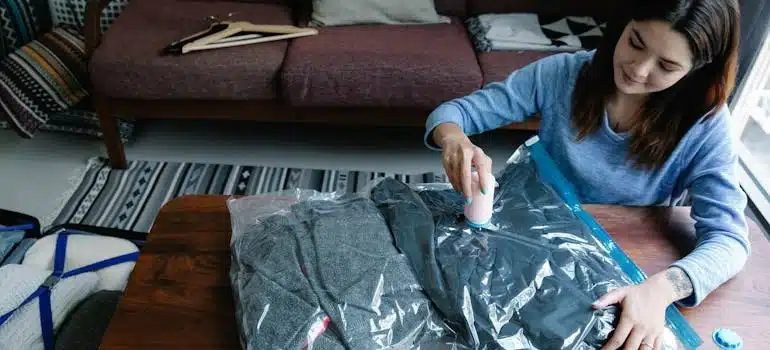
Decluttering methods that make sorting easier
Clutter often sticks around because decisions are postponed. Items pile up when you aren’t sure what to keep or where to put something. A structured method helps you take action faster and stay focused throughout the process.
Each of the following methods can help you declutter your home storage in a simple and repeatable way.
Try the 12-12-12 decluttering method
This method is quick, clear, and easy to repeat. You find 12 items to throw away, 12 items to donate, and 12 items to put back in the right place. That’s 36 decisions made in one round.
It works well for busy people because it doesn’t require long hours or complicated planning. Use this method once a week or once per room to declutter your home storage with ease.
Use the four-box technique
Label four boxes as keep, donate, toss, and relocate. Go through each item in your storage space and place it in one of these boxes. This method works well in closets, garages, and basements where item types vary.
For larger projects, having durable boxes ready makes the process faster and easier. Many South Florida residents use moving boxes in Miami from local suppliers or organizing services to sort and store items efficiently.
The goal is to handle each item only once. Avoid overthinking. Place it in the box that makes the most sense, then move on.
Apply the one-year rule
If you have not used something in the last year, it’s likely not essential. This rule helps you avoid holding onto items out of habit. It works well for clothing, kitchen supplies, seasonal decor, and old tools.
There are exceptions, but this method helps create clear guidelines so you can reduce clutter with more confidence.
These methods are most effective when you set a goal and apply them consistently. Start with one small area and work through it at your own pace. The next step is to apply these techniques in each space where storage tends to overflow.
How to declutter different storage spaces in your home
Each storage area in your home serves a different purpose. What works in a pantry may not work in a basement. You’ll get better results when you adjust your decluttering approach based on the type of space you’re organizing.
The following will show you how to apply practical decluttering tips for closets, basements, and pantries.
Organize and reset your closet
Start by emptying your closet completely. This gives you a clear view of everything stored inside. Sort your clothing by type—shirts, pants, jackets, and accessories—and focus on what you wear most often.
Ask yourself three key questions for each item. Does it fit? Do you wear it regularly? Is it in good condition? If the answer is no, consider donating or discarding it.
Once you’ve made your decisions, group similar items together. Use bins for small accessories and hang organizers for shoes or bags. Store seasonal clothing in labeled containers and rotate items as the seasons change.
Clean and pack anything you won’t wear for a while. Proper long-term clothing storage helps protect fabrics and makes better use of space.
Maintain your closet by doing a quick check every few months. Remove clothes you no longer wear and reorganize sections that look messy.
Reset and sort your pantry
To declutter your home storage with ease, always start with a full clear-out. Therefore, remove everything from your pantry and check each item’s expiration date. Throw away expired goods and combine open duplicates like rice, pasta, or cereals.
Wipe down shelves before placing anything back. Organize your food into groups—grains, canned goods, snacks, and baking supplies. Use clear containers for dry foods so you can see how much you have.
Place your most-used items at eye level. Store heavy or bulky products on lower shelves. Use turntables or risers for smaller items like spices and jars.
Check your pantry weekly before shopping. A five-minute review keeps things in order and avoids unnecessary purchases.
Each of these areas can stay organized with regular attention and small habits. The next step is to maintain your efforts with a few smart rules.
Declutter and zone your basement or attic
Spaces like basements, garages, and even attics often hold forgotten items. If you’re reclaiming attic space for daily use, consider removing what no longer serves a purpose. These steps often go hand in hand with remodeling your attic for living, especially when storage needs shift.
So, begin by identifying what your basement currently holds. Many basements collect old furniture, tools, boxes of decorations, and things people plan to fix or sort later.
Create simple zones based on item types. Place all tools in one corner, holiday items in another, and sports equipment in a separate area. Use shelving units to keep items off the floor and make them easier to access.
Be honest about what no longer serves a purpose. If something hasn’t moved or been used in years, consider removing it. Donate what you can, and recycle or dispose of broken or expired items.
Clear labeling helps prevent future clutter. Mark each bin or box with a permanent label so everyone in your household can find and return items quickly.
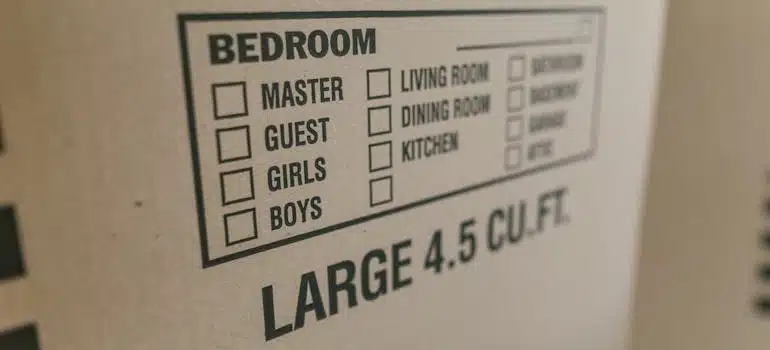
How to keep your home storage clutter-free
Decluttering once gives you a fresh start, but maintaining a clean home storage takes consistent effort. Clutter can return quickly if you don’t follow a few simple habits.
To declutter home storage long term, treat organization as part of your routine. These practical tips help you stay in control and keep your house storage useful every day.
Set a regular review schedule
Choose one day each month to check your home storage areas. Focus on closets, pantries, or basements; whichever needs the most attention. Remove anything you no longer use. This small routine supports organizing home storage without much effort.
Use the one-in, one-out rule
When you bring a new item into your house, remove something old. This habit prevents overflow and encourages mindful choices. It works well across all storage spaces—from kitchen shelves to bedroom closets.
Keep donation bins accessible
Place a donation bin in an easy-to-reach area. Use closets, laundry rooms, or garage corners. Drop items in the bin as soon as you realize you no longer need them. Once full, take it directly to a donation center.
Avoid impulse purchases
Ask yourself honest questions before you buy anything new. Will you use it regularly? Do you already own something similar? Stopping clutter before it enters your house storage is one of the smartest decluttering tips for your home.
Label storage containers clearly
Clear labels help everyone in the household find what they need and return it properly. Use printed tags or permanent markers on bins, boxes, and shelves. Even small spaces like home office storage can add to the overall clutter if left unchecked.
Labeling drawers, folders, and document boxes, especially during a move, keeps paperwork from piling up or getting misplaced. Thoughtful home office decluttering before moving also helps reduce what ends up packed away unnecessarily.
How to start decluttering when you feel stuck
It’s common to avoid decluttering because the task feels too big. If you feel stuck, focus on just one action. Start with a visible win—a drawer, a shelf, or a single bin. Use a timer and give yourself 15–30 minutes.
Avoid perfection. Your goal is not to finish the whole house but to move forward. Each small decision gives you more clarity. Once you build momentum, even bigger spaces like basements and pantries will feel easier to manage.
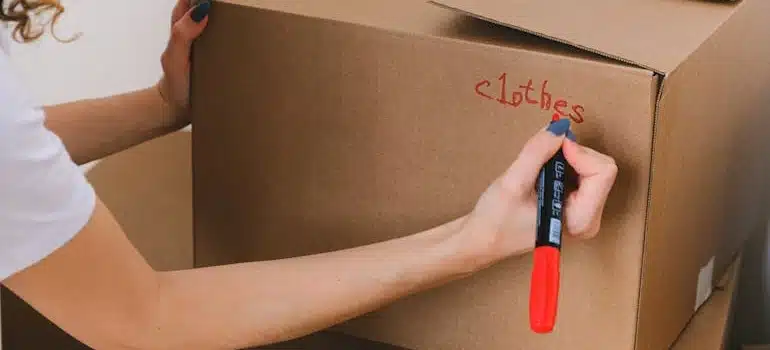
FAQ about how to declutter your home storage with ease
Many people have the same questions when they start decluttering. Below are simple, direct answers to help you move forward with clarity and enthusiasm.
Q: What is the 50% rule in decluttering?
A: The 50% rule in decluttering means removing half the items from any cluttered space. If your closet or pantry feels crowded, aim to reduce the total by 50%. You create space and still keep your most useful items.
Q: What are the 4 C’s of decluttering?
The 4 C’s of decluttering stand for Clutter, Clean, Categorize, and Contain.
- Clutter: Identify what doesn’t belong.
- Clean: Clear out and wipe down the area.
- Categorize: Group items by use or type.
- Contain: Use bins, shelves, or boxes to store things neatly.
The method works well in house storage spaces like basements and pantries, as well as when using storage services and off-site units.
Q: What is the fastest way to declutter a house?
A: The fastest way to declutter a house is to focus on high-traffic areas first. Use a timer and limit your sessions to 30–60 minutes. Apply quick methods like the 12-12-12 decluttering method to stay focused. Avoid deep cleaning or rearranging while sorting.
Q: What is the 12-12-12 rule for decluttering?
A: The 12-12-12 decluttering method asks you to find 12 items to throw away, 12 to donate, and 12 to return to their proper place. This method is simple, repeatable, and helps you make 36 decisions fast.
Q: How do I start decluttering when I feel overwhelmed?
A: To start decluttering when overwhelmed, choose a small, contained area, like one drawer or a single shelf. Set a timer for 15 minutes. Focus only on what you can do in that time. Avoid thinking about the whole house. One small win will help build momentum.
Q: What is a good declutter checklist?
A: A good declutter checklist includes the following steps:
- Pick one area (closet, shelf, drawer)
- Sort items into keep, toss, donate, and relocate
- Wipe down surfaces
- Return only the useful items
- Label containers if needed
You can apply this checklist to every part of your house storage.
Q: Can I declutter my house in one day?
A: You can make meaningful progress in one day if you stay focused. Start early, choose three high-impact areas, and work in short blocks. Have boxes ready for donating or trashing. Stick to sorting only. Don’t try to clean or reorganize everything at once.
Q: What if I have hoarding tendencies?
A: If you have hoarding tendencies, start small, go slow, and work with support. Focus on one category, such as clothes or papers. Ask someone you trust to help if possible. Avoid judgment and track small wins. Over time, you can clean home storage areas without feeling pressure to do it all.
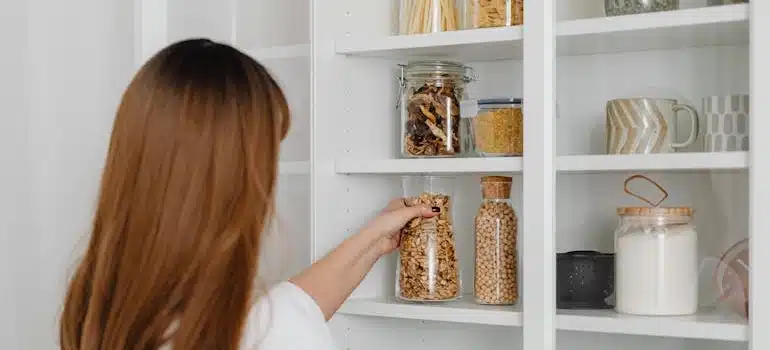
Why decluttering your home storage improves everyday life
Decluttering is not just about looks. It affects how your home works. When your storage is clean and organized, daily tasks get easier.
Many avoid starting because they expect the process to be hard. But once you apply simple strategies, you start to see real changes. You don’t need expensive tools or large chunks of time. You need a system that helps you make steady progress.
To declutter home storage in a way that lasts, focus on what you use, what adds value, and what no longer belongs. Then build habits that support that mindset every week.
Use these decluttering tips for the home that work in real life. The steps you take today will make your house storage more useful tomorrow. Declutter your home storage with ease, care, and purpose, and enjoy how much simpler your space becomes!
